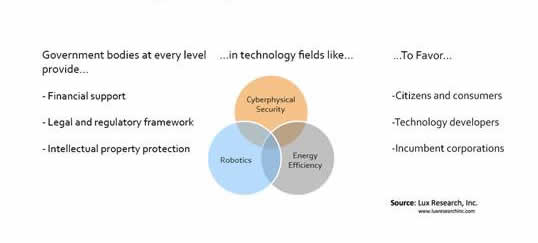How should governments allocate $55bn for ICT?
Federal, state and local governments pour an estimated $55bn into ICT but, according to Lux Research, better structuring of funding is needed to create better outcomes. Governments and IT developers should apply principles like modularity, scalability and interoperability to ICT funding itself - prioritising cyberphysical security and open-source IP in areas like the industrial internet and precision agriculture.
“While funding has obviously helped make the U.S. a global leader in ICT, government support has had mixed results,” said Mark Bünger, Vice President, Lux Research, and lead author of the report Funding the Future: How U.S. Federal, State, and Local Governments Support ICT Innovation. “When governments get too enthusiastic, their efforts contaminate the competition, rather than improving it. For the truly big challenges facing the world, this fragmented, non-collaborative and expensive approach threatens to undermine the very goals it seeks to achieve."

Government support for cyberphysical security, energy efficiency and robotics is interwoven
Lux Research analysts estimated aggregated government funding to ICT technologies and evaluated its impact on hot-button issues in this presidential election year, such as securing energy supply, defending against global and domestic terrorism, establishing leadership in autonomous vehicles and creating advanced manufacturing jobs. Their findings include:
- Defence tops federal funding. Of the estimated $40bn federal government funding on ICT programmes, nearly a quarter ($9.4bn), goes to the Defense Information Systems Agency (DISA).
- State funding is harder to measure. The best nationwide database on state ICT funding tracks 265,000 subsidy awards from 551 programmes for an estimated $140bn, spread out over a decade. Local city and regional governments vie for high-tech employers but their 'spending' usually comes in the form of tax breaks and zoning changes - which is often a zero-sum game for the country as a whole.
- Holistic approach is missing. Government support remains a patchwork, treating vital topics like cyberphysical security, energy efficiency and robotics as separate domains, subject to different regulatory bodies. In reality, IT, energy, vehicles, solar power and efficient buildings are one connected system. China, notably, is taking a more integrated approach around issues like electrification.


